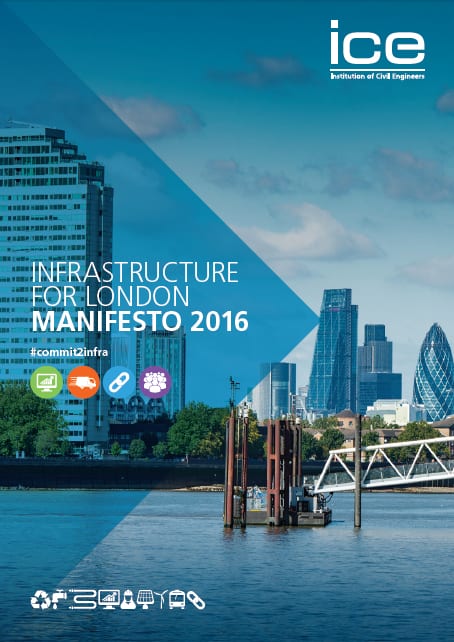The Institution of Civil Engineers (ICE) wants road user charging to be considered as a way of funding infrastructure improvements in London.
Launching its Infrastructure for London Manifesto in the lead up to the Mayoral and London Assembly elections in May of this year, ICE has set out ten recommendations for the next Mayor and London Assembly to help keep London top of the world’s cities.
The recommendations focus on four key areas: Strategy, Resilience, Skills and Delivery. Falling into the Delivery category, the recommendation looking at road user charging calls for innovation in delivering the funding needed to pay for the £1.3 trillion of investment in infrastructure in the UK capital. In addition, the bill for maintenance of the road network is estimated to cost £9bn in the next 35 years. In the manifesto it states: ICE London agrees that new infrastructure should require user charges that can bring a return on investment. Various proposed river crossings in the East, such as the Silvertown Tunnel as well as current crossings like the Blackwall Tunnel, will require user charges to reduce traffic flows and provide funding.
However, ICE London believes a complete review of road user charges is required
in London – particularly in relation to the Congestion Charge. The Congestion Charge is essential in order to manage vehicle use in a growing city and with congestion on London’s roads set to rise by 60% in 2031, the next Mayor must consider whether the charge is best targeting areas of high traffic and poor air quality.
The Manifesto also looked at road user charging as a means of controlling pollution and improving air quality in a city where it took less that a week for annual air pollution limits to be breached for nitrogen dioxide levels in 2016. It said: With new road user charges, London would experience improvements in air quality, reductions in carbon dioxide, nitrogen oxides and particle matter into the air. Air pollution has serious health implications with the Government estimating that 440,439 Londoners were exposed to unlawful Nitrogen Oxide levels in 2011.
Commenting on the launch, Suzanne Moroney, ICE London Director, said: “Over the past few years, a consensus has been growing amongst policymakers over the need for reliable and secure infrastructure to keep London competitive and successful. Now, the challenge we face is how we prioritise, pay for and deliver the upgrades the city requires.
“Our Manifesto for London’s Infrastructure sets out a number of recommendations as to how the next Mayor and London Assembly Members can do that. From supporting the work City Hall has already carried out on London’s infrastructure, to finding alternative and innovative ways to fund new schemes, the Manifesto sets out a clear roadmap of what needs to be done.
“Decisions made over the next Mayoral term will be pivotal to the ability of London to deal with a growing population and climate change. It is now for the candidates to set out their stalls and say what they will do to back London’s infrastructure systems.”
To read the Infrastructure for London Manifesto in full click here; you can also view a short summary video here.
ICE London’s 10 recommendations for London’s next Mayor and London Assembly:
Strategy
1) Commit to the London Infrastructure Plan 2050 and set out a clear prioritisation strategy within 6 months of entering City Hall.
2) Support the Government’s final decision on the 2015 Airports Commission Report.
3) Create a Regional Forum for authorities from London and the South East to discuss key infrastructure issues.
Resilience
4) Develop a “London Resilience Plan 2050” mapping out how the capital will adapt to long-term climate changes and environmental disasters.
5) Improve energy efficiency and increase local energy generation.
Skills
6) Expand STEM in the London Curriculum and the London Schools Excellence Fund.
7) Launch a skills campaign to increase the number of qualified civil engineers in London.
Delivery
8) Focus Transport for London’s investment to unlock areas for housing, jobs and investment in the capital.
9) Harness different funding and finance methods to pay for London’s infrastructure.
10) Review road user charges with the revenue generated directed to infrastructure improvements.





